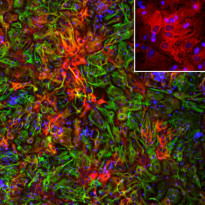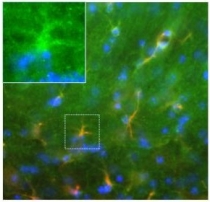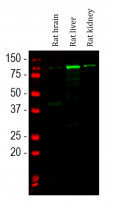ARG10692
anti-ALDH1L1 antibody
anti-ALDH1L1 antibody for ICC/IF,IHC-Frozen sections,Western blot and Human,Mouse,Rat,Cow,Horse,Pig
Overview
| Product Description | Rabbit Polyclonal antibody recognizes ALDH1L1 |
|---|---|
| Tested Reactivity | Hu, Ms, Rat, Cow, Hrs, Pig |
| Predict Reactivity | Chk |
| Tested Application | ICC/IF, IHC-Fr, WB |
| Host | Rabbit |
| Clonality | Polyclonal |
| Isotype | IgG |
| Target Name | ALDH1L1 |
| Antigen Species | Human |
| Immunogen | Full length Human ALDH1L1 protein. |
| Conjugation | Un-conjugated |
| Alternate Names | 10-fTHF; EC 1.5.1.6; FDH; Aldehyde dehydrogenase family 1 member L1; FTHFD; 10-FTHFDH; Cytosolic 10-formyltetrahydrofolate dehydrogenase |
Application Instructions
| Application Suggestion |
|
||||||||
|---|---|---|---|---|---|---|---|---|---|
| Application Note | * The dilutions indicate recommended starting dilutions and the optimal dilutions or concentrations should be determined by the scientist. |
Properties
| Form | Liquid |
|---|---|
| Purification | Unpurified. |
| Buffer | Serum. |
| Storage Instruction | For continuous use, store undiluted antibody at 2-8°C for up to a week. For long-term storage, aliquot and store at -20°C or below. Storage in frost free freezers is not recommended. Avoid repeated freeze/thaw cycles. Suggest spin the vial prior to opening. The antibody solution should be gently mixed before use. |
| Note | For laboratory research only, not for drug, diagnostic or other use. |
Bioinformation
| Database Links | |
|---|---|
| Gene Symbol | ALDH1L1 |
| Gene Full Name | aldehyde dehydrogenase 1 family, member L1 |
| Background | The protein encoded by this gene catalyzes the conversion of 10-formyltetrahydrofolate, nicotinamide adenine dinucleotide phosphate (NADP+), and water to tetrahydrofolate, NADPH, and carbon dioxide. The encoded protein belongs to the aldehyde dehydrogenase family. Loss of function or expression of this gene is associated with decreased apoptosis, increased cell motility, and cancer progression. There is an antisense transcript that overlaps on the opposite strand with this gene locus. Alternative splicing results in multiple transcript variants. [provided by RefSeq, Jun 2012] |
| Calculated MW | 99 kDa |
Images (5) Click the Picture to Zoom In
-
ARG10692 anti-ALDH1L1 antibody ICC/IF image
Immunocytochemistry: Rat mixed neuron-glial cell mixture cultures stained with ARG10692 anti-ALDH1L1 antibody (red) and co-stained with monoclonal 5C10 against GFAP (green). ARG10692 anti-ALDH1L1 antibody stains astrocytes and excludes from neuron cells. ALDH1L1 stains the astrocytes cell body and processes, whereas GFAP labels the intermediate filament of the cytoskeleton in subset of astrocytes. Astrocytes are positive for both ALDH1L1 and GFAP appear yellow. ALDH1L1 also labels many astrocytes not labelled by GFAP, which appear as red.
-
ARG10692 anti-ALDH1L1 antibody ICC/IF image
Immunofluorescence: Cortical neuron-glial cells from E20 Rat stained with ARG10692 anti-ALDH1L1 antibody (red) at 1:1000 dilution and costained with ARG52313 anti-GFAP antibody (green) at 1:5000 dilution. DAPI (blue) for nuclear staining.
The ALDH1L1 antibody labels protein expressed in the cytoplasm of non-neuronal cells. The GFAP antibody stains intermediate filaments in astrocytes and other glial cells.
-
ARG10692 anti-ALDH1L1 antibody IHC-Fr image
Immunohistochemistry: Frozen sections of Mouse brain (fixed by transcardial perfusion of 4% paraformaldehyde) stained with ARG10692 anti-ALDH1L1 antibody (green) and Clone 5C10 (red). Along the corpus callosum (white matter), ARG10692 anti-ALDH1L1 antibody labels astrocytes that also heavily express GFAP. As a result, astrocytes in this area appear to be gold to yellow. Inset shows a magnified image. Nuclei are labeled with DAPI (blue).
-
ARG10692 anti-ALDH1L1 antibody WB image
Western blot: Rat liver tissue homogenates stained with ARG10692 anti-ALDH1L1 antibody.
-
ARG10692 anti-ALDH1L1 antibody WB image
Western blot: Rat brain, Rat liver and Rat kidney lysates stained with ARG10692 anti-ALDH1L1 antibody (green) at 1:5000 dilution.










